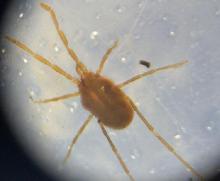Microorganisms decompose a number of different materials, such as fallen leaves, in order to constitute the nutrient rich soil found in forests. Many creatures are able to thrive in this soil, the most numerous of which are ticks. These small creatures are arthropods, meaning they possess a shell and joints, similar to the rhinoceros beetle and the crab. Ticks most resemble spiders, even though they grow to be 1cm long at most, and less than 1mm long on average (about the size of a grain of sand). Large numbers of ticks live in soil, but there are also ticks that live in people’s homes. The tick breathes using spiracles, or breathing holes, on both sides of its body. Ticks feed on bacteria, fungi, and smaller ticks. Sometimes they end up being eaten by spiders, larger ticks, centipedes, and other such insects. Even in places without water, the tick is able survive without actually drinking water by sucking up water vapor. The secret lies in a special liquid that comes out of its mouth. First, the tick uses two legs to search for air with a high level of humidity (air that contains a lot of water). Once it finds such air, the tick releases a special liquid from its mouth that absorbs water. The tick re-swallows this liquid, thereby retrieving water from the air.
- Resouce/Energy/Information Collection & Storage:
- Water recovery
We can imagine developing materials that are able to retrieve water from the air. If we can develop containers with this material, they could be used to collect water simply by leaving them open for several hours at a time. This would be extremely useful in times of disaster when water is in great need, but little is available. The tick’s ability to generate its own water supply could also help out with the technological development of disaster supplies, including emergency food supplies that are often freeze-dried and need water for their preparation. The tick’s method of sucking up water vapor in the air could be used to maintain comfortable residential conditions for people living in dry regions. Air systems could collect water from the air (both internally and externally) in order to effectively control humidity levels inside the buildings without the need for humidifiers or dehumidifiers in each room. Regardless of the weather, people would be able to live comfortably.


















